Amorphous Alumina ALD Coatings for the Protection of Limestone Cultural Heritage Objects
Abstract
:1. Introduction
2. Materials and Methods
2.1. Sample Preparation
2.2. Reflectance and Colorimetry
2.3. FTIR-ATR
2.4. Aqueous Acid Immersion and pH and pCa Tracking
2.5. Optical Microscopy
2.6. SEM-EDX
3. Results and Discussion
3.1. Appearance Changes
3.2. Verifying the Presence of ALD Alumina with FTIR-ATR
3.3. Morphology and Homogeneity of the ALD Coatings on Istria
3.4. pH Evolution to Measure Protection against Acid Attack
3.5. Optical Imaging
3.6. ICP-OES Analysis
3.7. Elemental and Morphological Changes from Acid Immersion
4. Conclusions
5. Patents
Supplementary Materials
Author Contributions
Funding
Institutional Review Board Statement
Informed Consent Statement
Data Availability Statement
Acknowledgments
Conflicts of Interest
References
- Brimblecombe, P. The Effects of Air Pollution on the Built Environment; Imperial College Press: London, UK, 2003; ISBN 978-1-84816-128-3. [Google Scholar]
- Sabbioni, C. Mechanisms of Air Pollution Damage to Stone. In Air Pollution Reviews; Imperial College Press: London, UK, 2003; Volume 2, pp. 63–106. ISBN 978-1-86094-291-4. [Google Scholar]
- Vidal, F.; Vicente, R.; Mendes Silva, J. Review of Environmental and Air Pollution Impacts on Built Heritage: 10 Questions on Corrosion and Soiling Effects for Urban Intervention. J. Cult. Herit. 2019, 37, 273–295. [Google Scholar] [CrossRef]
- Vidović, K.; Hočevar, S.; Menart, E.; Drventić, I.; Grgić, I.; Kroflič, A. Impact of Air Pollution on Outdoor Cultural Heritage Objects and Decoding the Role of Particulate Matter: A Critical Review. Environ. Sci. Pollut. Res. 2022, 29, 46405–46437. [Google Scholar] [CrossRef] [PubMed]
- Brimblecombe, P.; Grossi, C.M. Millennium-Long Damage to Building Materials in London. Sci. Total Environ. 2009, 407, 1354–1361. [Google Scholar] [CrossRef] [PubMed]
- Ghedini, N.; Ozga, I.; Bonazza, A.; Dilillo, M.; Cachier, H.; Sabbioni, C. Atmospheric Aerosol Monitoring as a Strategy for the Preventive Conservation of Urban Monumental Heritage: The Florence Baptistery. Atmos. Environ. 2011, 45, 5979–5987. [Google Scholar] [CrossRef]
- Belfiore, C.M.; Barca, D.; Bonazza, A.; Comite, V.; La Russa, M.F.; Pezzino, A.; Ruffolo, S.A.; Sabbioni, C. Application of Spectrometric Analysis to the Identification of Pollution Sources Causing Cultural Heritage Damage. Environ. Sci. Pollut. Res. 2013, 20, 8848–8859. [Google Scholar] [CrossRef] [PubMed]
- Maas, R.; Grennfelt, P.; Amann, M.; Harnett, B.; Kerr, J.; Berton, E.; Pritula, D.; Reiss, I.; Almodovar, P.; Héroux, M.-E.; et al. Towards Cleaner Air—Scientific Assessment Report 2016; Narayana Press: Gylling, Denmark, 2016. [Google Scholar]
- Grennfelt, P.; Engleryd, A.; Forsius, M.; Hov, Ø.; Rodhe, H.; Cowling, E. Acid Rain and Air Pollution: 50 Years of Progress in Environmental Science and Policy. Ambio 2020, 49, 849–864. [Google Scholar] [CrossRef] [PubMed]
- Annual Mean NO2 Concentrations Observed at (Sub)Urban Background Stations. Available online: https://www.eea.europa.eu/data-and-maps/daviz/annual-mean-no2-concentration-observed-7#tab-googlechartid_chart_21 (accessed on 9 June 2024).
- Trends in Atmospheric Concentrations of CO2 (Ppm), CH4 (Ppb) and N2O (Ppb), between 1800 and 2017. Available online: https://www.eea.europa.eu/data-and-maps/daviz/atmospheric-concentration-of-carbon-dioxide-5 (accessed on 9 June 2024).
- Maravelaki-Kalaitzaki, P.; Biscontin, G. Origin, Characteristics and Morphology of Weathering Crusts on Istria Stone in Venice. Atmos. Environ. 1999, 33, 1699–1709. [Google Scholar] [CrossRef]
- Biscontin, G.; Fassina, V.; Miaravelaki, P.; Zendri, E. Venice: Stone Material Behaviour in Connection with the Environment. MRS Proc. 1990, 185, 253. [Google Scholar] [CrossRef]
- Gnemmi, M.; Falchi, L.; Zendri, E. Non-Invasive-Monitoring Methodology for the Evaluation of Environmental Impacts on Istrian Stone Surfaces in Venice. Atmosphere 2022, 13, 1036. [Google Scholar] [CrossRef]
- Pivato, A.; Pegoraro, L.; Masiol, M.; Bortolazzo, E.; Bonato, T.; Formenton, G.; Cappai, G.; Beggio, G.; Giancristofaro, R.A. Long Time Series Analysis of Air Quality Data in the Veneto Region (Northern Italy) to Support Environmental Policies. Atmos. Environ. 2023, 298, 119610. [Google Scholar] [CrossRef]
- Artesani, A.; Di Turo, F.; Zucchelli, M.; Traviglia, A. Recent Advances in Protective Coatings for Cultural Heritage–An Overview. Coatings 2020, 10, 217. [Google Scholar] [CrossRef]
- Doehne, E.F.; Price, C.A. Stone Conservation: An Overview of Current Research, 2nd ed.; Research in Conservation; Getty Conservation Institute: Los Angeles, CA, USA, 2010; ISBN 978-1-60606-046-9. [Google Scholar]
- Fistos, T.; Fierascu, I.; Doni, M.; Chican, I.E.; Fierascu, R.C. A Short Overview of Recent Developments in the Application of Polymeric Materials for the Conservation of Stone Cultural Heritage Elements. Materials 2022, 15, 6294. [Google Scholar] [CrossRef] [PubMed]
- Melo, M.J.; Bracci, S.; Camaiti, M.; Chiantore, O.; Piacenti, F. Photodegradation of Acrylic Resins Used in the Conservation of Stone. Polym. Degrad. Stab. 1999, 66, 23–30. [Google Scholar] [CrossRef]
- Gherardi, F.; Maravelaki, P.N. (Eds.) Conserving Stone Heritage: Traditional and Innovative Materials and Techniques; Cultural Heritage Science; Springer International Publishing: Cham, Swizerland, 2022; ISBN 978-3-030-82941-4. [Google Scholar]
- Kim, H.-M.; Kim, D.-G.; Kim, Y.-S.; Kim, M.; Park, J.-S. Atomic Layer Deposition for Nanoscale Oxide Semiconductor Thin Film Transistors: Review and Outlook. Int. J. Extrem. Manuf. 2023, 5, 012006. [Google Scholar] [CrossRef]
- Sheng, J.; Lee, J.-H.; Choi, W.-H.; Hong, T.; Kim, M.; Park, J.-S. Review Article: Atomic Layer Deposition for Oxide Semiconductor Thin Film Transistors: Advances in Research and Development. J. Vac. Sci. Technol. A Vac. Surf. Film. 2018, 36, 060801. [Google Scholar] [CrossRef]
- George, S.M. Atomic Layer Deposition: An Overview. Chem. Rev. 2010, 110, 111–131. [Google Scholar] [CrossRef]
- Ishibe, T.; Maeda, Y.; Terada, T.; Naruse, N.; Mera, Y.; Kobayashi, E.; Nakamura, Y. Resistive Switching Memory Performance in Oxide Hetero-Nanocrystals with Well-Controlled Interfaces. Sci. Technol. Adv. Mater. 2020, 21, 195–204. [Google Scholar] [CrossRef]
- Rebenne, H.E.; Bhat, D.G. Review of CVD TiN Coatings for Wear-Resistant Applications: Deposition Processes, Properties and Performance. Surf. Coat. Technol. 1994, 63, 1–13. [Google Scholar] [CrossRef]
- Kayanuma, M.; Choe, Y.-K.; Hagiwara, T.; Kameda, N.; Shimoi, Y. Theoretical Study of the Mechanism for the Reaction of Trimethylaluminum with Ozone. ACS Omega 2021, 6, 26282–26292. [Google Scholar] [CrossRef]
- Oh, I.-K.; Sandoval, T.E.; Liu, T.-L.; Richey, N.E.; Nguyen, C.T.; Gu, B.; Lee, H.-B.-R.; Tonner-Zech, R.; Bent, S.F. Elucidating the Reaction Mechanism of Atomic Layer Deposition of Al2O3with a Series of Al(CH3)xCl3–x and Al(CyH2y+1)3 Precursors. J. Am. Chem. Soc. 2022, 144, 11757–11766. [Google Scholar] [CrossRef]
- Puurunen, R.L.; Vandervorst, W. Island Growth as a Growth Mode in Atomic Layer Deposition: A Phenomenological Model. J. Appl. Phys. 2004, 96, 7686–7695. [Google Scholar] [CrossRef]
- Naumann, V.; Otto, M.; Wehrspohn, R.B.; Werner, M.; Hagendorf, C. Interface and Material Characterization of Thin ALD-Al2O3 Layers on Crystalline Silicon. Energy Procedia 2012, 27, 312–318. [Google Scholar] [CrossRef]
- Young, M.J.; Bedford, N.M.; Yanguas-Gil, A.; Letourneau, S.; Coile, M.; Mandia, D.J.; Aoun, B.; Cavanagh, A.S.; George, S.M.; Elam, J.W. Probing the Atomic-Scale Structure of Amorphous Aluminum Oxide Grown by Atomic Layer Deposition. ACS Appl. Mater. Interfaces 2020, 12, 22804–22814. [Google Scholar] [CrossRef] [PubMed]
- Porter, D.A.; Easterling, K.E. Phase Transformations in Metals and Alloys, 2nd ed.; Springer-Science & Business Media: Berlin, Germany, 1992. [Google Scholar]
- Ritala, M.; Leskelä, M.; Dekker, J.-P.; Mutsaers, C.; Soininen, P.J.; Skarp, J. Perfectly Conformal TiN and Al2O3 Films Deposited by Atomic Layer Deposition. Chem. Vap. Depos. 1999, 5, 7–9. [Google Scholar] [CrossRef]
- Shkondin, E.; Takayama, O.; Lindhard, J.M.; Larsen, P.V.; Mar, M.D.; Jensen, F.; Lavrinenko, A.V. Fabrication of High Aspect Ratio TiO2 and Al2O3 Nanogratings by Atomic Layer Deposition. J. Vac. Sci. Technol. A Vac. Surf. Film. 2016, 34, 031605. [Google Scholar] [CrossRef]
- Marquardt, A.E.; Breitung, E.M.; Drayman-Weisser, T.; Gates, G.; Phaneuf, R.J. Protecting Silver Cultural Heritage Objects with Atomic Layer Deposited Corrosion Barriers. Herit. Sci. 2015, 3, 37. [Google Scholar] [CrossRef]
- Hiebert, M.E.; Weaver, J.; Lam, T.; Little, N.; Hyde, E.; Vicenzi, E.P.; Phaneuf, R.J.; Smithsonian Institution; National Institute of Standards and Technology. ALD Deposited Amorphous Alumina Coatings Can Slow Glass Alteration. Phys. Chem. Glas. Eur. J. Glass Sci. Technol. B 2022, 63, 97–110. [Google Scholar] [CrossRef]
- Sundaram, G.M.; Bertuch, A.; Bhatia, R.; Coutu, R.; Dalberth, M.J.; Deguns, E.; Liu, G.; Sowa, M.J.; Becker, J.S. (Invited) Large Format Atomic Layer Deposition. ECS Trans. 2010, 33, 429–440. [Google Scholar] [CrossRef]
- Beneq Launches the World’s Largest ALD Reactor: The Beneq P1500. Available online: https://beneq.com/en/beneq-launches-the-worlds-largest-ald-reactor-the-beneq-p1500/ (accessed on 9 June 2024).
- Puurunen, R.L. Surface Chemistry of Atomic Layer Deposition: A Case Study for the Trimethylaluminum/Water Process. J. Appl. Phys. 2005, 97, 121301. [Google Scholar] [CrossRef]
- Groner, M.D.; Fabreguette, F.H.; Elam, J.W.; George, S.M. Low-Temperature Al2O3 Atomic Layer Deposition. Chem. Mater. 2004, 16, 639–645. [Google Scholar] [CrossRef]
- Sciarretta, F.; Eslami, J.; Beaucour, A.-L.; Noumowé, A. State-of-the-Art of Construction Stones for Masonry Exposed to High Temperatures. Constr. Build. Mater. 2021, 304, 124536. [Google Scholar] [CrossRef]
- Hutchinson, J.W. Stresses and Failure Modes in Thin Films and Multilayers: Notes for a Dcamm Course. 1996. Available online: https://citeseerx.ist.psu.edu/document?repid=rep1&type=pdf&doi=445a05fac9019c9be1f6ba77904e706f8ba262a3 (accessed on 9 June 2024).
- Maravelaki-Kalaitzaki, P.; Bertoncello, R.; Biscontin, G. Evaluation of the Initial Weathering Rate of Istria Stone Exposed to Rain Action, in Venice, with X-Ray Photoelectron Spectroscopy. J. Cult. Herit. 2002, 3, 273–282. [Google Scholar] [CrossRef]
- Costantini, R.; Balliana, E.; Dalla Torre, D.; Aricò, F.; Zendri, E. Evaluating the Impacts of Alcohol-Based Solutions on Silk: Chemical, Mechanical and Wettability Changes before and after Artificial Ageing. Heritage 2022, 5, 3588–3604. [Google Scholar] [CrossRef]
- Izzo, F.C.; Balliana, E.; Perra, E.; Zendri, E. Accelerated Ageing Procedures to Assess the Stability of an Unconventional Acrylic-Wax Polymeric Emulsion for Contemporary Art. Polymers 2020, 12, 1925. [Google Scholar] [CrossRef] [PubMed]
- Langereis, E.; Heil, S.B.S.; Knoops, H.C.M.; Keuning, W.; Van De Sanden, M.C.M.; Kessels, W.M.M. In Situ Spectroscopic Ellipsometry as a Versatile Tool for Studying Atomic Layer Deposition. J. Phys. D Appl. Phys. 2009, 42, 073001. [Google Scholar] [CrossRef]
- Beche, E.; Fournel, F.; Larrey, V.; Rieutord, F.; Fillot, F. Direct Wafer Bonding of Amorphous or Densified Atomic Layer Deposited Alumina Thin Films. Microsyst. Technol. 2015, 21, 953–959. [Google Scholar] [CrossRef]
- Chartier, G. Introduction to Optics; Advanced Texts in Physics; Springer: New York, NY, USA, 2005; ISBN 978-0-387-40346-5. [Google Scholar]
- Johnston-Feller, R. Color Science in the Examination of Museum Objects: Nondestructive Procedures. Color Res. Appl. 2002, 27, 456–457. [Google Scholar] [CrossRef]
- Sjöberg, E.L.; Rickard, D.T. Calcite Dissolution Kinetics: Surface Speciation and the Origin of the Variable pH Dependence. Chem. Geol. 1984, 42, 119–136. [Google Scholar] [CrossRef]
- Ebert, W.L.; Bates, J.K. The Importance of Secondary Phases in Glass Corrosion. MRS Proc. 1990, 212, 89. [Google Scholar] [CrossRef]
- Willis, S.A.; McGuinness, E.K.; Li, Y.; Losego, M.D. Re-Examination of the Aqueous Stability of Atomic Layer Deposited (ALD) Amorphous Alumina (Al2O3) Thin Films and the Use of a Postdeposition Air Plasma Anneal to Enhance Stability. Langmuir 2021, 37, 14509–14519. [Google Scholar] [CrossRef]
- Parsons, R. Atlas of Electrochemical Equilibria in Aqueous Solutions. J. Electroanal. Chem. Interfacial Electrochem. 1967, 13, 471. [Google Scholar] [CrossRef]
- Correa, G.C.; Bao, B.; Strandwitz, N.C. Chemical Stability of Titania and Alumina Thin Films Formed by Atomic Layer Deposition. ACS Appl. Mater. Interfaces 2015, 7, 14816–14821. [Google Scholar] [CrossRef] [PubMed]
- Barnhisel, R.I.; Rich, C.I. Gibbsite, Bayerite, and Nordstrandite Formation as Affected by Anions, pH, and Mineral Surfaces. Soil Sci. Soc. Am. J. 1965, 29, 531–534. [Google Scholar] [CrossRef]
- Schoen, R.; Roberson, C.E. Structures of Aluminum Hydroxide and Geochemical Implications. Am. Mineral. 1970, 55, 43–77. [Google Scholar]
- Fan, W.; Li, W. Morphology-Control Techniques for Preparing Aluminum Hydroxide via Wet Chemical Synthesis. Hydrometallurgy 2020, 192, 105256. [Google Scholar] [CrossRef]
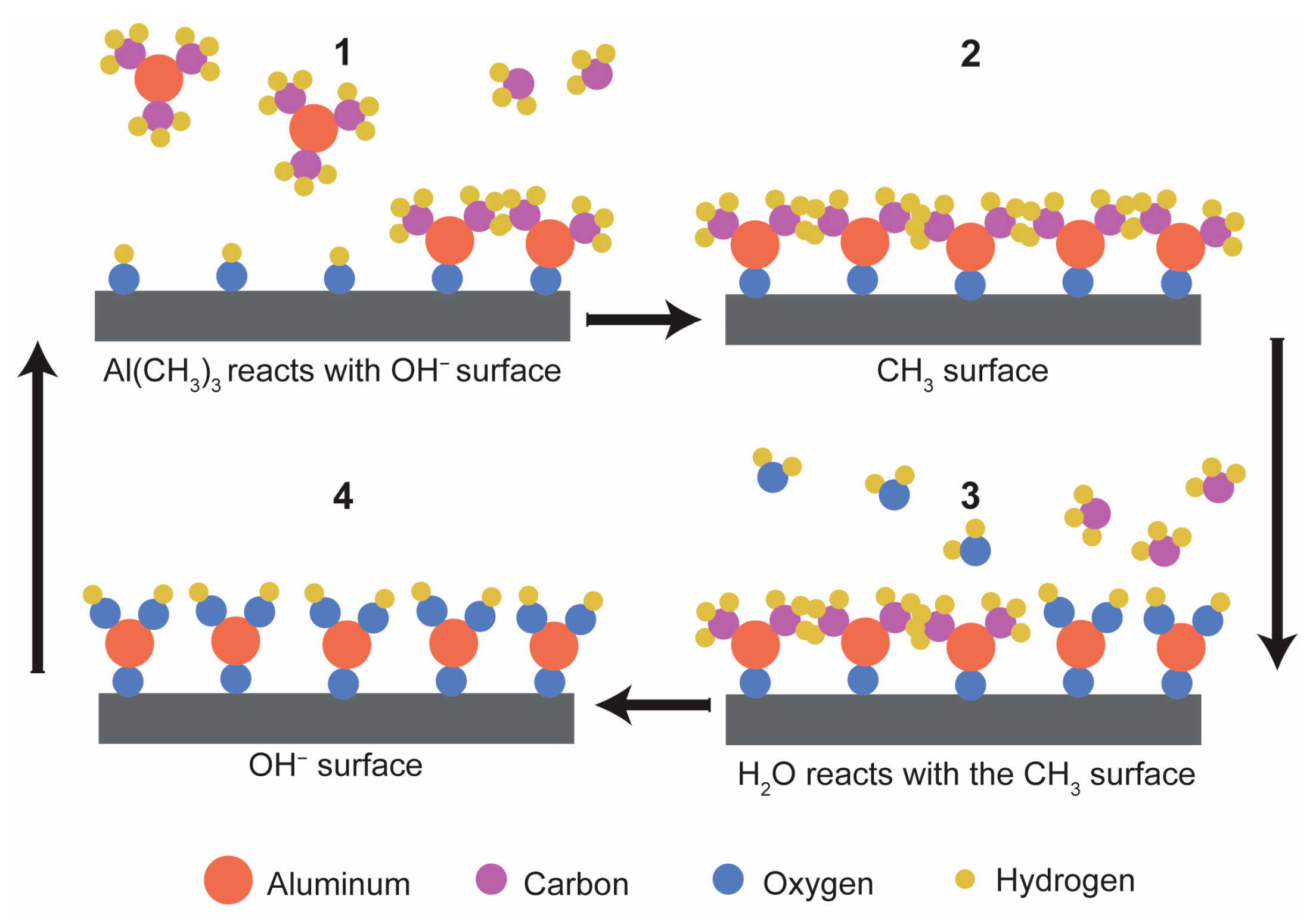
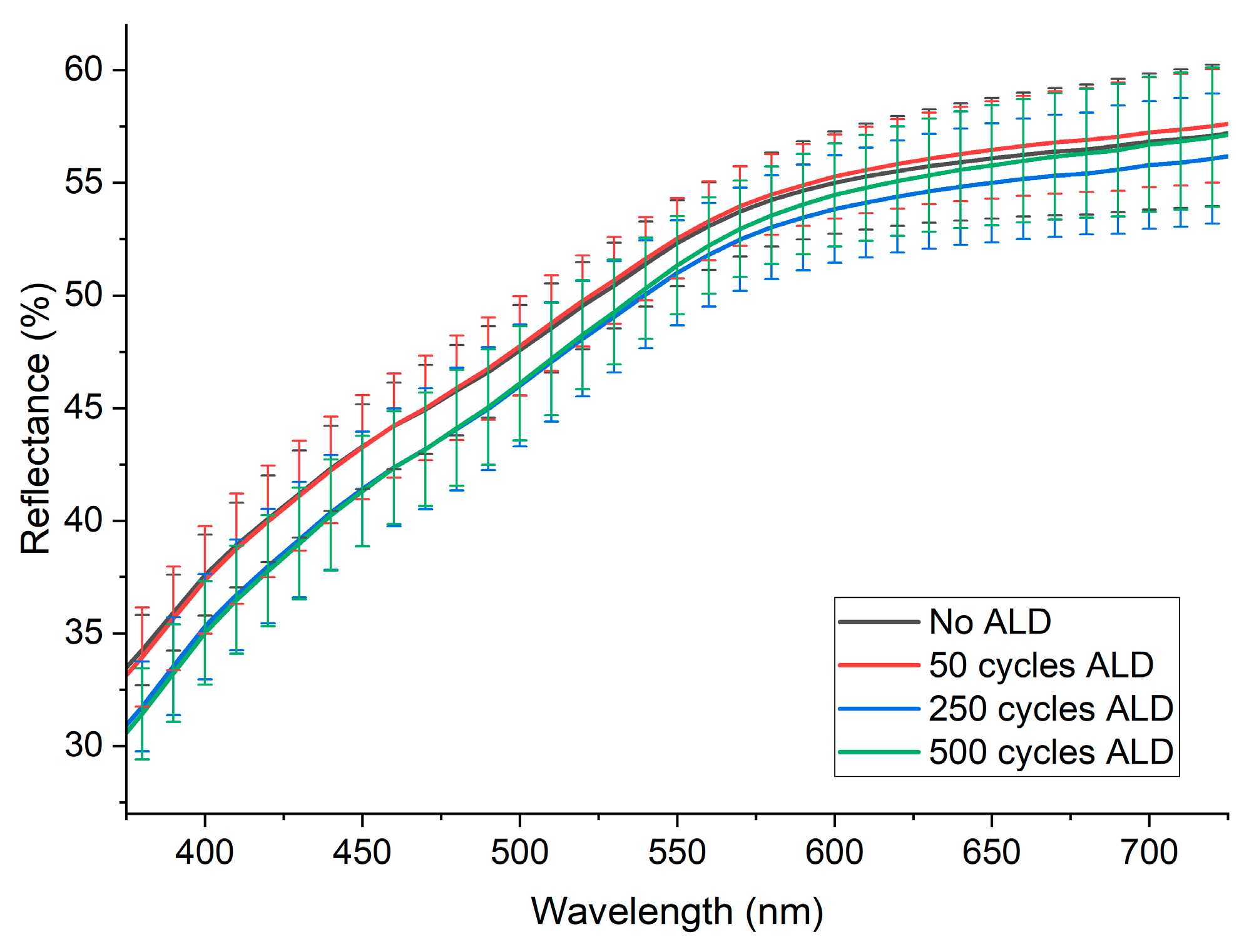
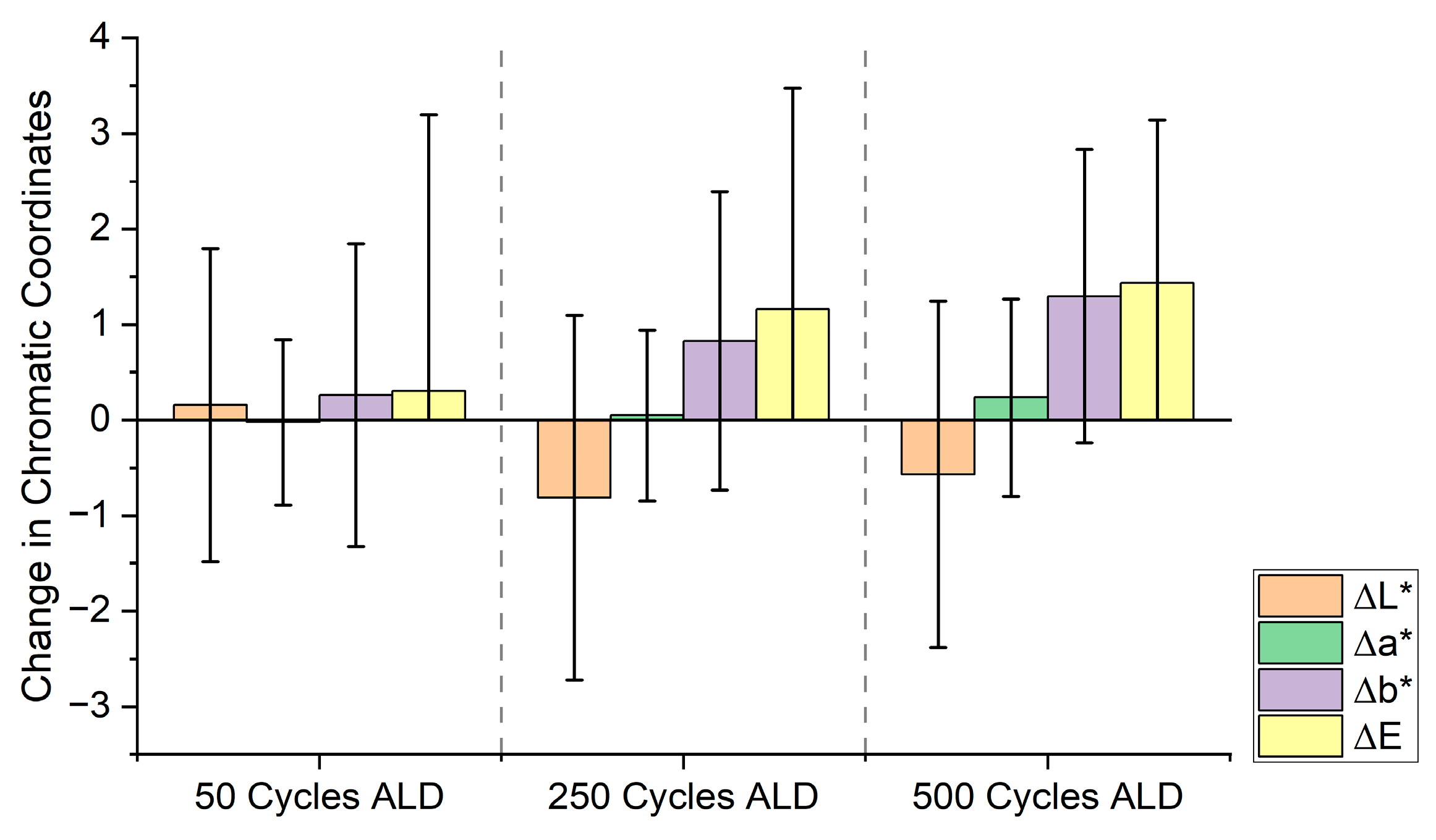
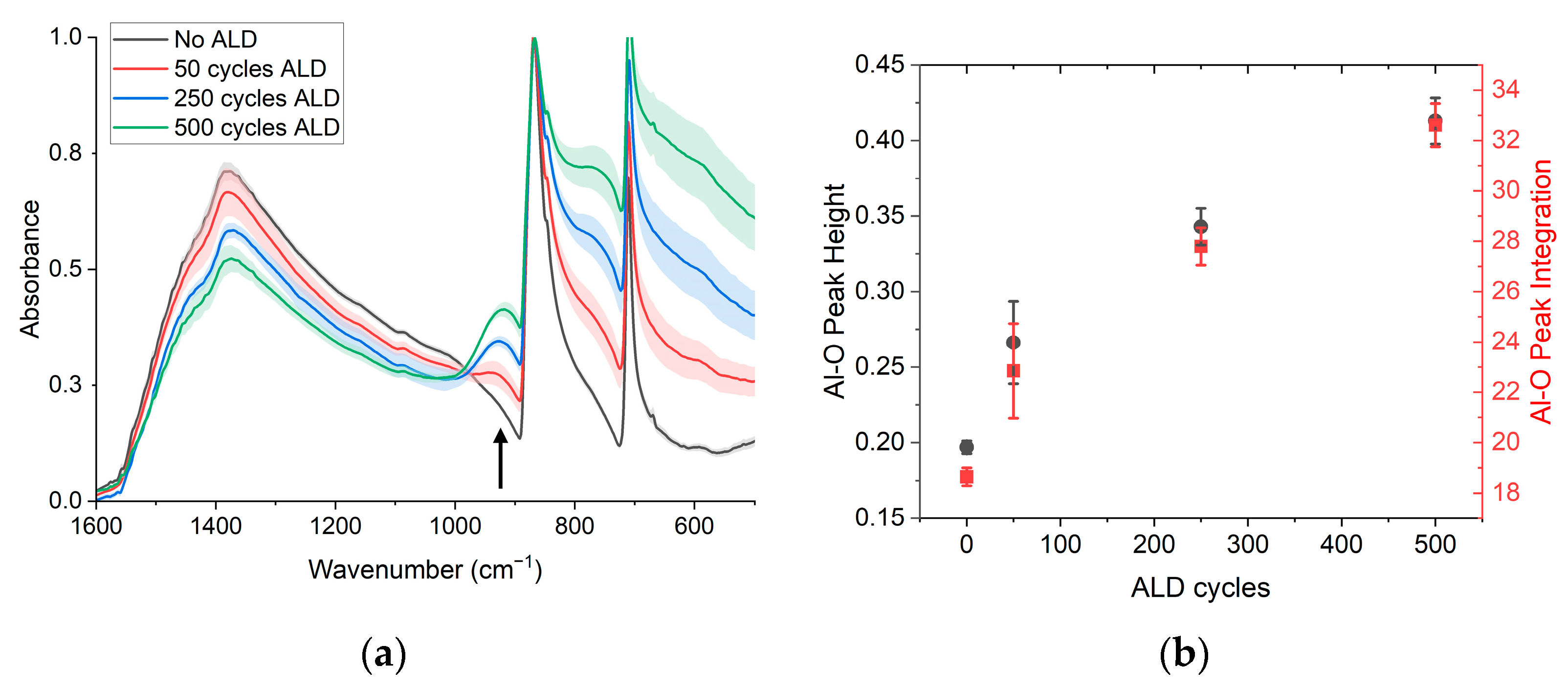

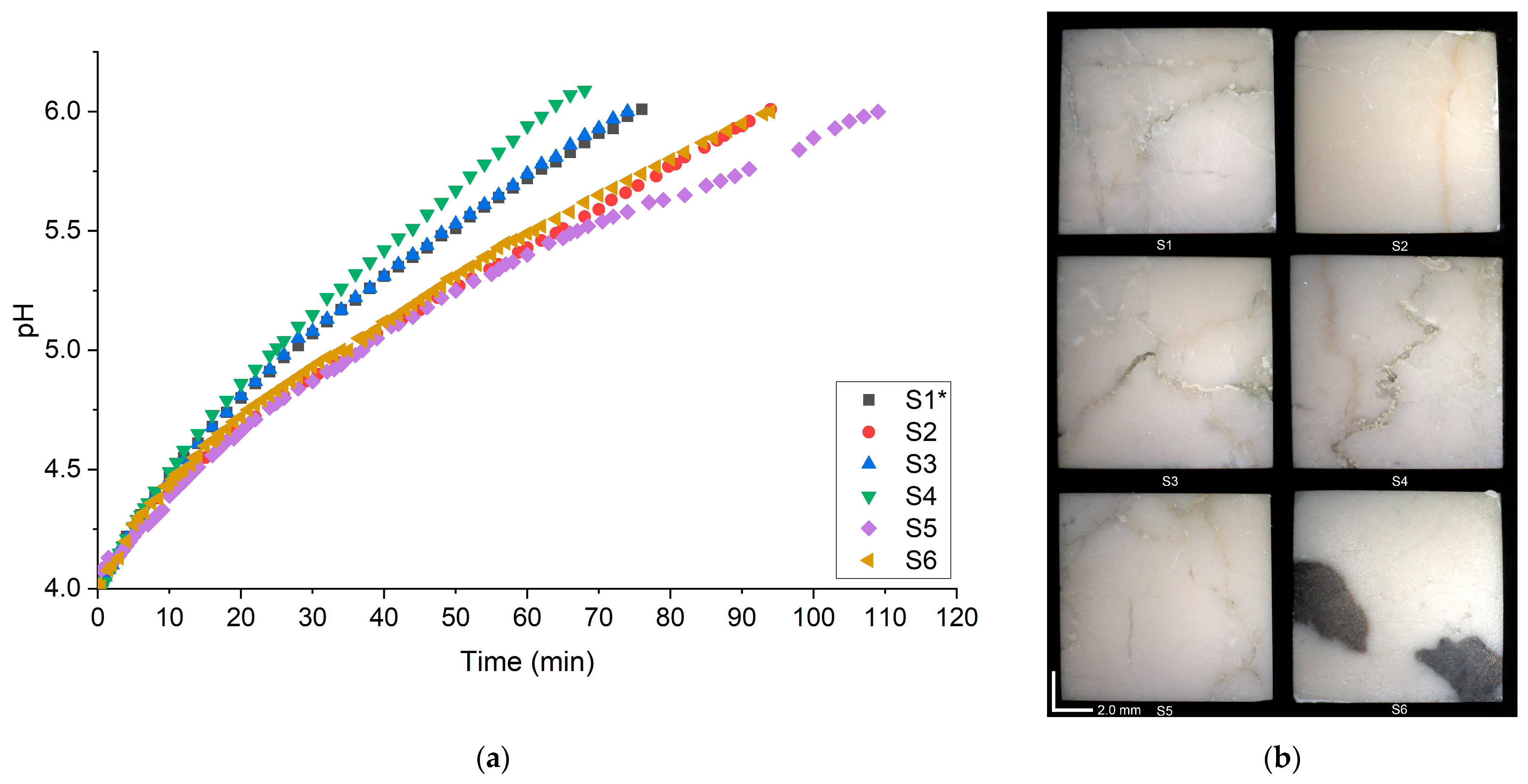
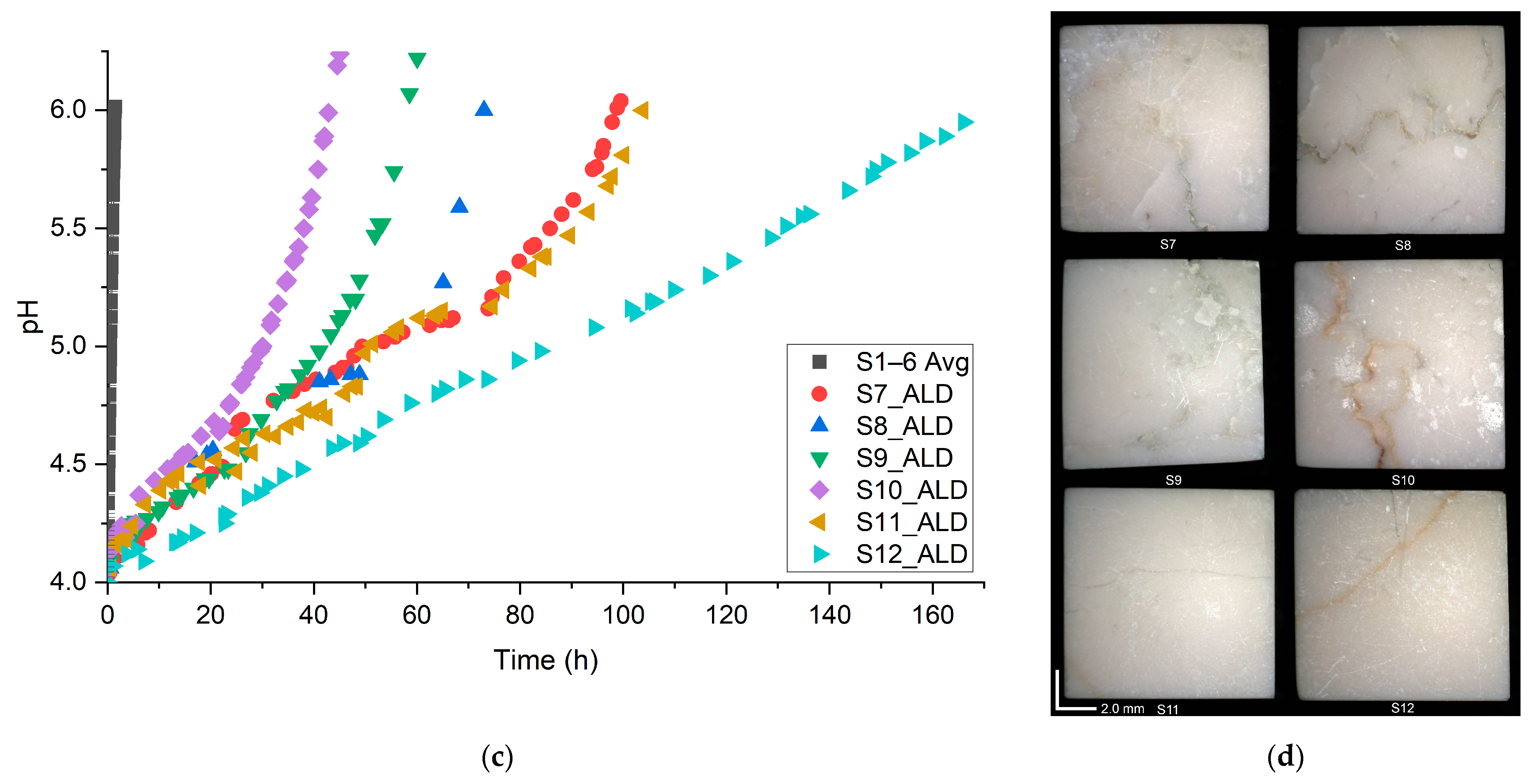

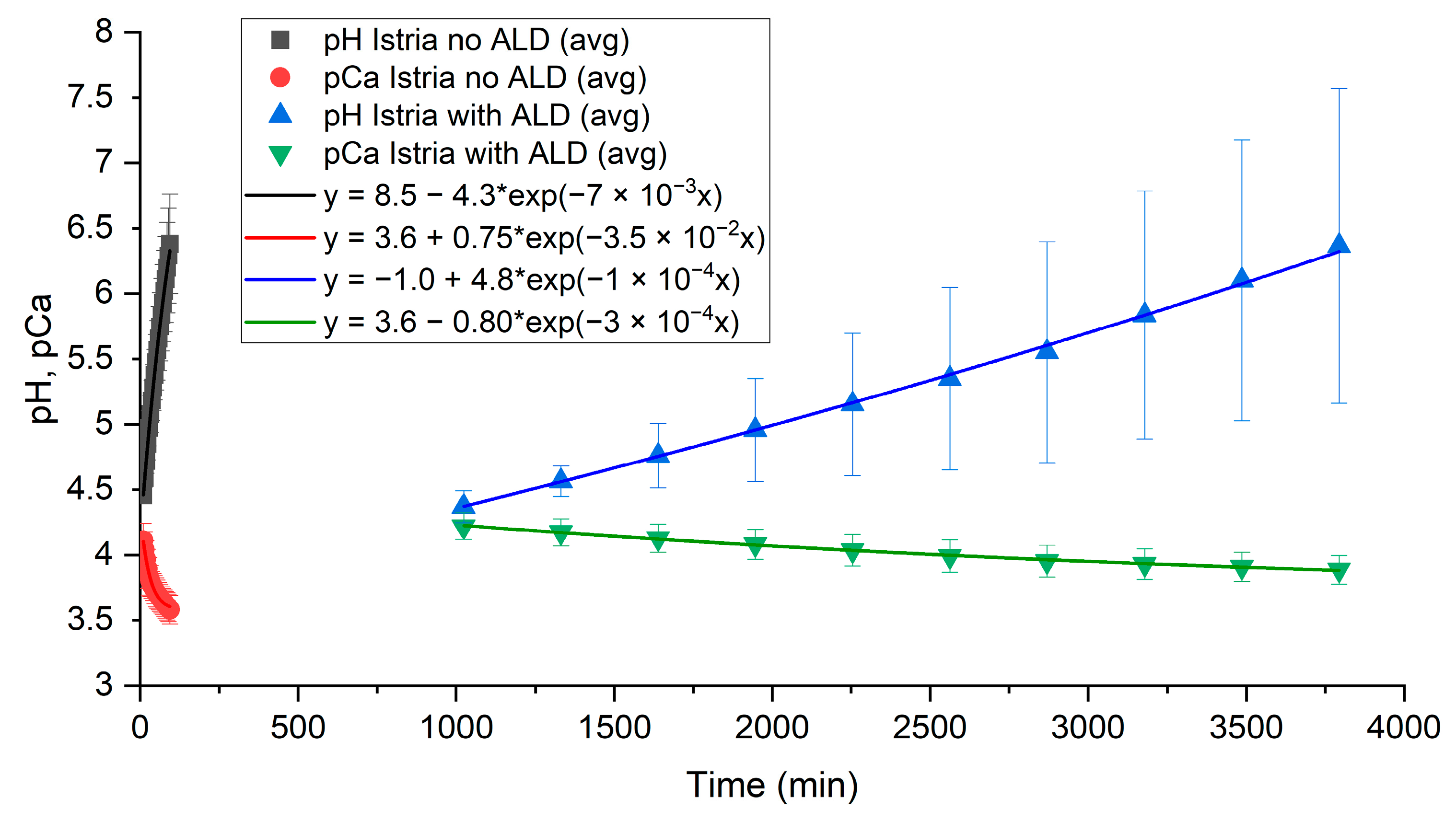
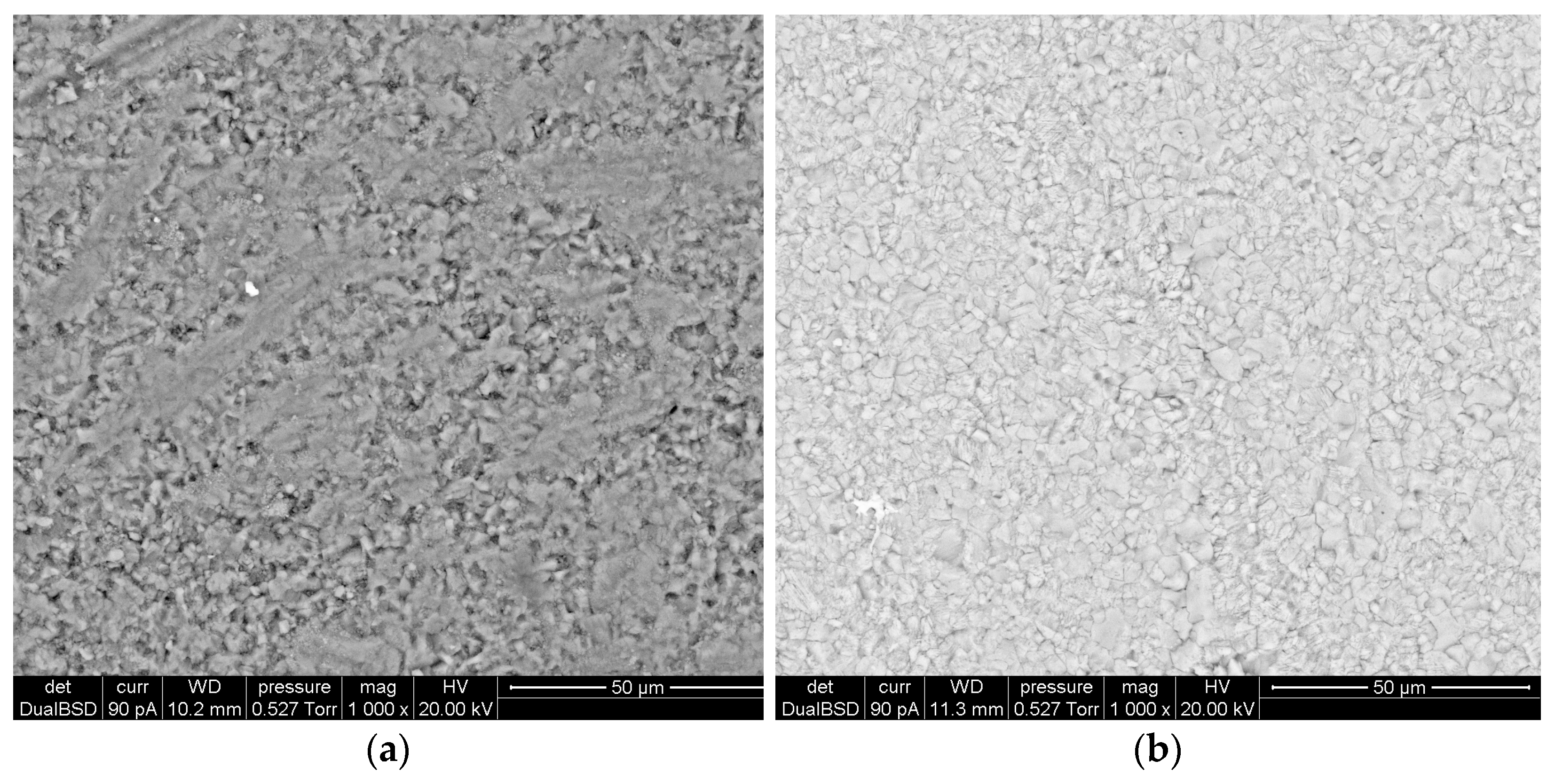

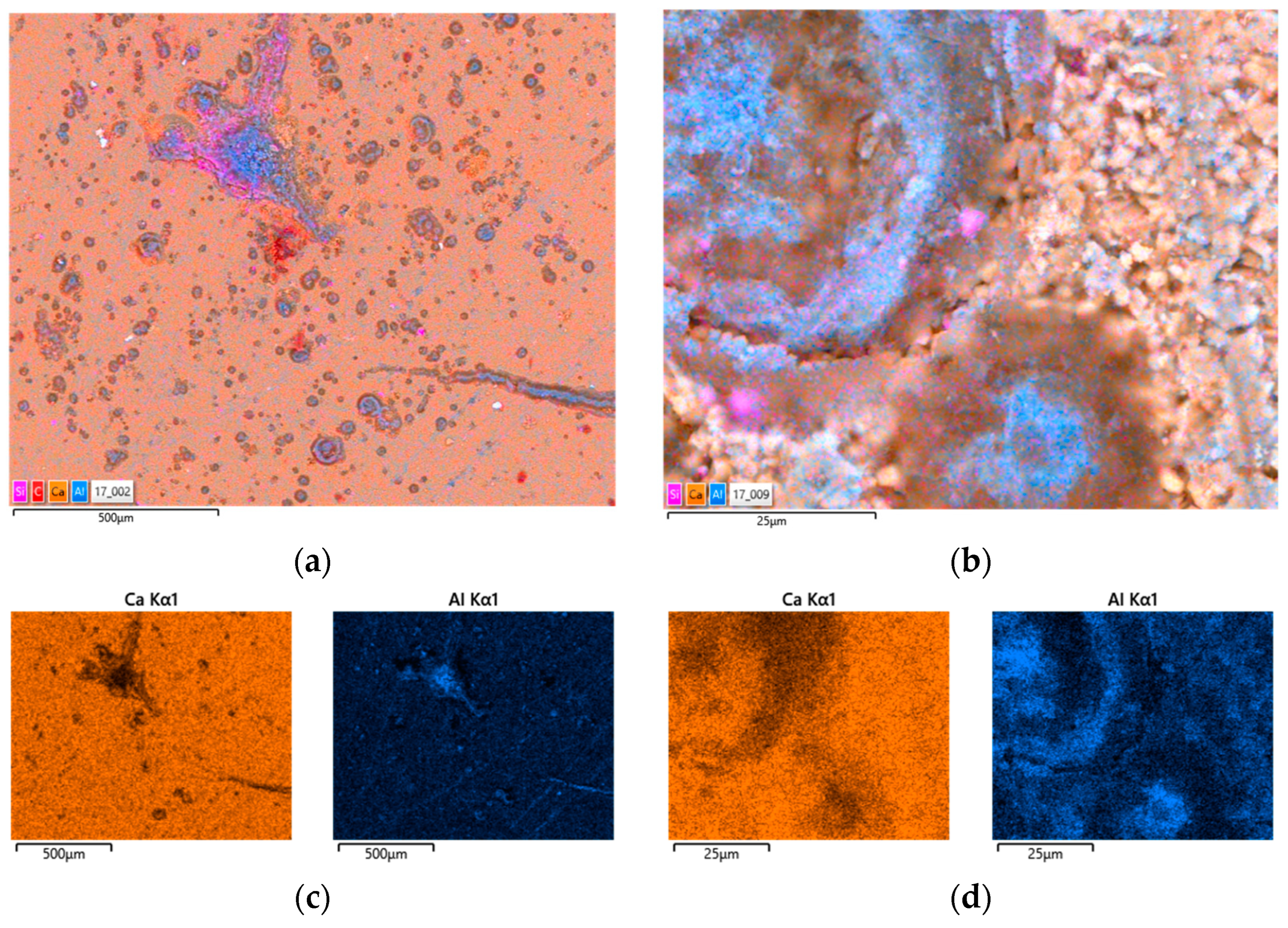
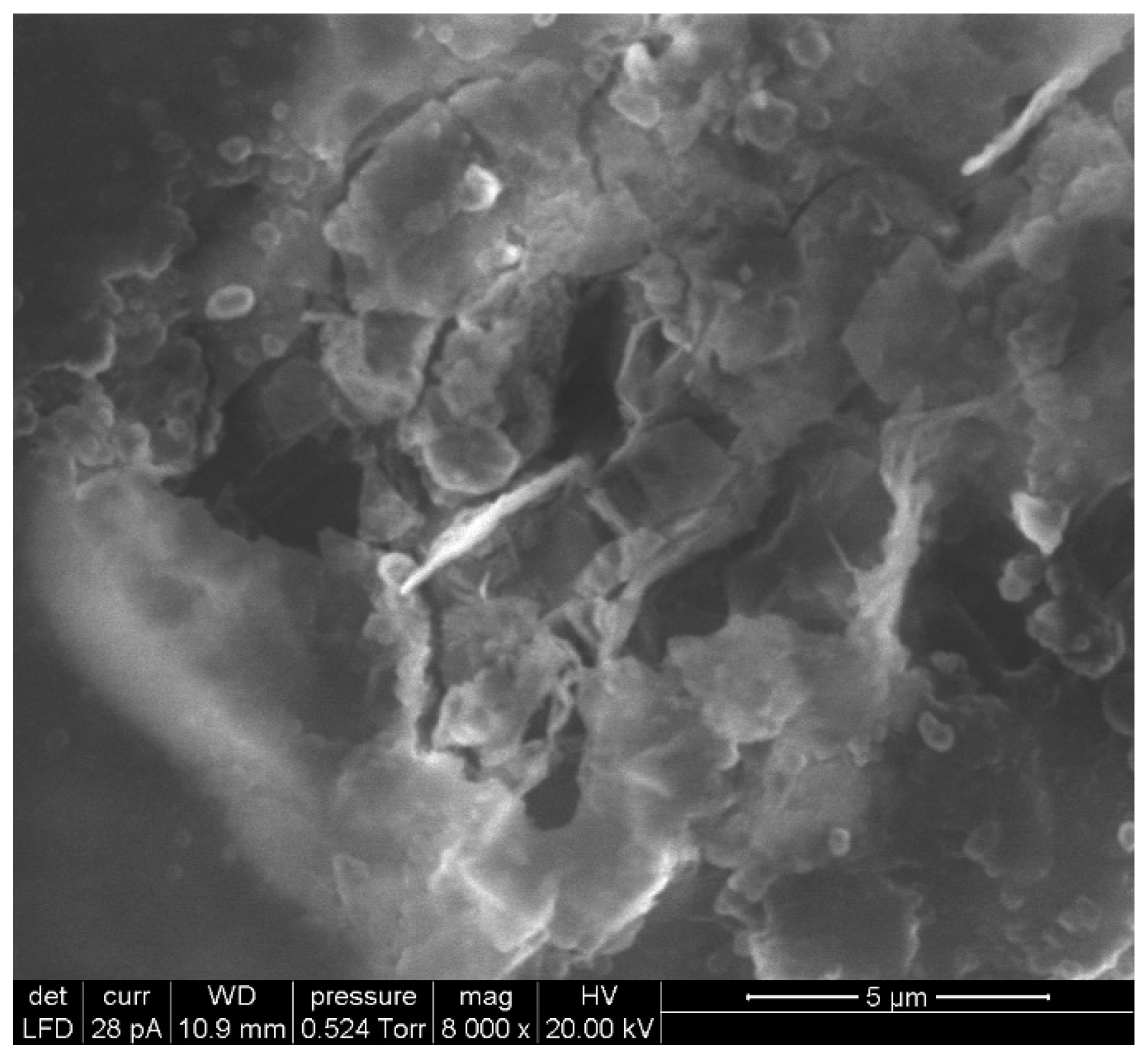
Disclaimer/Publisher’s Note: The statements, opinions and data contained in all publications are solely those of the individual author(s) and contributor(s) and not of MDPI and/or the editor(s). MDPI and/or the editor(s) disclaim responsibility for any injury to people or property resulting from any ideas, methods, instructions or products referred to in the content. |
© 2024 by the authors. Licensee MDPI, Basel, Switzerland. This article is an open access article distributed under the terms and conditions of the Creative Commons Attribution (CC BY) license (https://creativecommons.org/licenses/by/4.0/).
Share and Cite
Boyce, G.P.; Sreenilayam, S.; Balliana, E.; Zendri, E.; Phaneuf, R.J. Amorphous Alumina ALD Coatings for the Protection of Limestone Cultural Heritage Objects. Coatings 2024, 14, 931. https://doi.org/10.3390/coatings14080931
Boyce GP, Sreenilayam S, Balliana E, Zendri E, Phaneuf RJ. Amorphous Alumina ALD Coatings for the Protection of Limestone Cultural Heritage Objects. Coatings. 2024; 14(8):931. https://doi.org/10.3390/coatings14080931
Chicago/Turabian StyleBoyce, Gillian P., Suveena Sreenilayam, Eleonora Balliana, Elisabetta Zendri, and Raymond J. Phaneuf. 2024. "Amorphous Alumina ALD Coatings for the Protection of Limestone Cultural Heritage Objects" Coatings 14, no. 8: 931. https://doi.org/10.3390/coatings14080931




